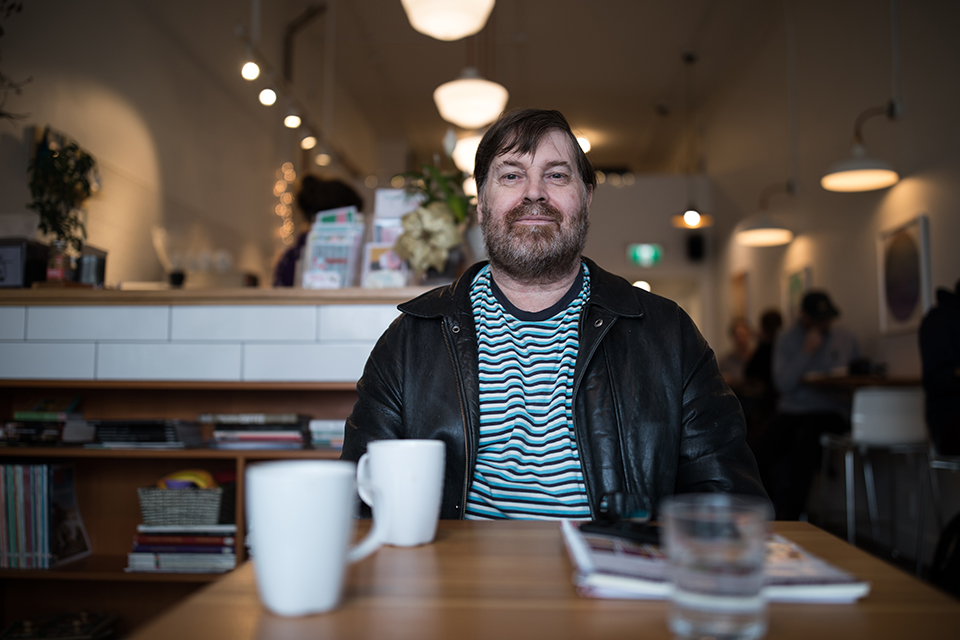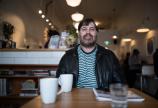Crossword constructor: Martin Ashwood-Smith
- Stephanie Harrington

Martin Ashwood-Smith creates crosswords for top publications, challenging puzzle solvers to fill in those square spaces
Martin Ashwood-Smith (BA ’92) likens his signature crossword puzzles to good magic tricks. Part alchemy, part craft, part art, the Victoria-based constructor who has published 1,000 crossword puzzles—including 85 in the cruciverbalist’s holy grail, The New York Times—starts with a grid. And very few black squares.
His specialty is very difficult, very dense puzzles that feature four 15-letter answers stacked on top of each other—“quad stacks” in crossword parlance. His puzzles somewhat resemble a Tetris game gone awry. His second-best trick is the triple stack, which inspires equal awe among his fans, who relish tackling these “huge seas of white,” as one blogger put it.
More than 20 years ago, not long after graduating from history at UVic, Ashwood-Smith became fascinated with American-style wide-open grid crosswords. One is on his lap as we speak. He’s working on another for The New York Times (two are forthcoming in the next six months). The task could take him seven or eight hours to complete once he’s in the groove, or he could toil two weeks and get nowhere.
“It’s a labour of obsession at times,” Ashwood-Smith quips.
Ashwood-Smith’s process unfolds like this: after sketching an interesting grid, most often with a pencil and graph paper, he will try to populate it. Ashwood-Smith will consult his word list, a magpie collection of one million nouns, verbs, phrases and adjectives saved on his laptop. To demonstrate its power, he searches the database, honed over decades of working as a professional constructor, for a term or phrase with a “t” in the third position, and an “e” in thirteenth position.
“How many words fit that? ‘Totally clueless,’ that’s actually pretty good,” he says.
Although first attracted to the technical side of crossword construction, Ashwood-Smith remains a discerning word-nerd at heart.
Some words are just plain dull. 'Remorselessness,' that’s a 15-letter word but not that interesting. 'American pale ale,' now that’s an interesting phrase.
—Martin Ashwood-Smith, UVic alumnus
A puzzle in progress, he says, “will begin to look a little like a Jackson Pollock painting with letters.” Ashwood-Smith will push on, overcoming the blank squares, interlocking various word combinations. Crosswords have etiquette: they are apolitical in content and Ashwood-Smith avoids crass terms as well as medical ones.
Ashwood-Smith writes the clues last. For British-style cryptic crosswords or themed puzzles, such as the one he designed for the Torch, he starts with clues, and then works in reverse.
Ashwood-Smith designed his first crossword puzzle for the Martlet in the late ’70s with a friend. Fuelled by afternoon beers at the Student Union Building pub, and still many years away from perfecting the triple and quad stacks for which he has become known, Ashwood-Smith built on his skills, column by column.
When Monday Magazine rejected one of his puzzles, a friend suggested he send it to The New York Times. Weeks later, to Ashwood-Smith’s surprise, he received an acceptance letter, and thus joined the ranks of some 500 professional crossword constructors in North America today.
After university Ashwood-Smith drove a cab, a job he figured was short-term but which he continued for 23 years. Few of his fares would have known their London-born cabbie was responsible for the weekend angst of readers of The Washington Post, USA Today and, of course, The New York Times.
The elusive trick of Ashwood-Smith’s career might be the quint-stack, which you may have guessed is five 15-letter answers stacked on top of each other. Some years ago he worked on one with another constructor.
“It’s the one that got away. There had never been a symmetrical quint-stack puzzle ever,” Ashwood-Smith says. “They look ridiculous because they’re huge. There are no black squares for miles.”
The duo thought they had achieved the impossible—they came up with five 15-letter words and Ashwood-Smith found a way to make the puzzle symmetrical.
“We were really happy.”
Then they found the spelling mistake.
Which brings us to Ashwood-Smith’s top quality for aspiring crossword constructors: patience, an attribute he must have in spades.
Around the Ring crossword puzzle
Download the crossword puzzle (PDF) that Ashwood-Smith created for The Torch (Autumn 2018) and the answers (PDF).

